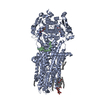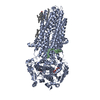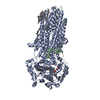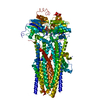[English] 日本語
 Yorodumi
Yorodumi- PDB-5w81: Phosphorylated, ATP-bound structure of zebrafish cystic fibrosis ... -
+ Open data
Open data
- Basic information
Basic information
| Entry | Database: PDB / ID: 5w81 | ||||||
|---|---|---|---|---|---|---|---|
| Title | Phosphorylated, ATP-bound structure of zebrafish cystic fibrosis transmembrane conductance regulator (CFTR) | ||||||
 Components Components | Cystic fibrosis transmembrane conductance regulator | ||||||
 Keywords Keywords |  HYDROLASE / HYDROLASE /  CFTR / CFTR /  anion channel / anion channel /  ABC transporter / ATP-bound. ABC transporter / ATP-bound. | ||||||
| Function / homology |  Function and homology information Function and homology informationABC-family proteins mediated transport / RHO GTPases regulate CFTR trafficking / Cargo recognition for clathrin-mediated endocytosis /  Clathrin-mediated endocytosis / RHOQ GTPase cycle / Kupffer's vesicle development / lymphoid lineage cell migration into thymus / Spemann organizer formation at the embryonic shield / Clathrin-mediated endocytosis / RHOQ GTPase cycle / Kupffer's vesicle development / lymphoid lineage cell migration into thymus / Spemann organizer formation at the embryonic shield /  regulation of neutrophil chemotaxis / Ub-specific processing proteases ...ABC-family proteins mediated transport / RHO GTPases regulate CFTR trafficking / Cargo recognition for clathrin-mediated endocytosis / regulation of neutrophil chemotaxis / Ub-specific processing proteases ...ABC-family proteins mediated transport / RHO GTPases regulate CFTR trafficking / Cargo recognition for clathrin-mediated endocytosis /  Clathrin-mediated endocytosis / RHOQ GTPase cycle / Kupffer's vesicle development / lymphoid lineage cell migration into thymus / Spemann organizer formation at the embryonic shield / Clathrin-mediated endocytosis / RHOQ GTPase cycle / Kupffer's vesicle development / lymphoid lineage cell migration into thymus / Spemann organizer formation at the embryonic shield /  regulation of neutrophil chemotaxis / Ub-specific processing proteases / Aggrephagy / regulation of neutrophil chemotaxis / Ub-specific processing proteases / Aggrephagy /  channel-conductance-controlling ATPase / intracellularly ATP-gated chloride channel activity / transepithelial water transport / germ cell migration / respiratory burst involved in defense response / multicellular organismal-level water homeostasis / bicarbonate transmembrane transporter activity / bicarbonate transport / channel-conductance-controlling ATPase / intracellularly ATP-gated chloride channel activity / transepithelial water transport / germ cell migration / respiratory burst involved in defense response / multicellular organismal-level water homeostasis / bicarbonate transmembrane transporter activity / bicarbonate transport /  pancreas development / embryonic hemopoiesis / pancreas development / embryonic hemopoiesis /  chloride channel activity / chloride channel activity /  chloride channel complex / T cell differentiation / ATPase-coupled transmembrane transporter activity / ABC-type transporter activity / cellular response to forskolin / chloride channel complex / T cell differentiation / ATPase-coupled transmembrane transporter activity / ABC-type transporter activity / cellular response to forskolin /  isomerase activity / chloride transmembrane transport / recycling endosome membrane / isomerase activity / chloride transmembrane transport / recycling endosome membrane /  heart development / early endosome membrane / defense response to bacterium / apical plasma membrane / heart development / early endosome membrane / defense response to bacterium / apical plasma membrane /  innate immune response / endoplasmic reticulum membrane / innate immune response / endoplasmic reticulum membrane /  ATP hydrolysis activity / ATP hydrolysis activity /  ATP binding / ATP binding /  membrane / membrane /  plasma membrane / plasma membrane /  cytosol cytosolSimilarity search - Function | ||||||
| Biological species |   Danio rerio (zebrafish) Danio rerio (zebrafish) | ||||||
| Method |  ELECTRON MICROSCOPY / ELECTRON MICROSCOPY /  single particle reconstruction / single particle reconstruction /  cryo EM / Resolution: 3.37 Å cryo EM / Resolution: 3.37 Å | ||||||
 Authors Authors | Zhang, Z. / Liu, F. / Chen, J. | ||||||
 Citation Citation |  Journal: Cell / Year: 2017 Journal: Cell / Year: 2017Title: Conformational Changes of CFTR upon Phosphorylation and ATP Binding. Authors: Zhe Zhang / Fangyu Liu / Jue Chen /  Abstract: The cystic fibrosis transmembrane conductance regulator (CFTR) is an anion channel evolved from an ATP-binding cassette transporter. CFTR channel gating is strictly coupled to phosphorylation and ATP ...The cystic fibrosis transmembrane conductance regulator (CFTR) is an anion channel evolved from an ATP-binding cassette transporter. CFTR channel gating is strictly coupled to phosphorylation and ATP hydrolysis. Previously, we reported essentially identical structures of zebrafish and human CFTR in the dephosphorylated, ATP-free form. Here, we present the structure of zebrafish CFTR in the phosphorylated, ATP-bound conformation, determined by cryoelectron microscopy to 3.4 Å resolution. Comparison of the two conformations shows major structural rearrangements leading to channel opening. The phosphorylated regulatory domain is disengaged from its inhibitory position; the nucleotide-binding domains (NBDs) form a "head-to-tail" dimer upon binding ATP; and the cytoplasmic pathway, found closed off in other ATP-binding cassette transporters, is cracked open, consistent with CFTR's unique channel function. Unexpectedly, the extracellular mouth of the ion pore remains closed, indicating that local movements of the transmembrane helices can control ion access to the pore even in the NBD-dimerized conformation. | ||||||
| History |
|
- Structure visualization
Structure visualization
| Movie |
 Movie viewer Movie viewer |
|---|---|
| Structure viewer | Molecule:  Molmil Molmil Jmol/JSmol Jmol/JSmol |
- Downloads & links
Downloads & links
- Download
Download
| PDBx/mmCIF format |  5w81.cif.gz 5w81.cif.gz | 251.9 KB | Display |  PDBx/mmCIF format PDBx/mmCIF format |
|---|---|---|---|---|
| PDB format |  pdb5w81.ent.gz pdb5w81.ent.gz | 194.8 KB | Display |  PDB format PDB format |
| PDBx/mmJSON format |  5w81.json.gz 5w81.json.gz | Tree view |  PDBx/mmJSON format PDBx/mmJSON format | |
| Others |  Other downloads Other downloads |
-Validation report
| Arichive directory |  https://data.pdbj.org/pub/pdb/validation_reports/w8/5w81 https://data.pdbj.org/pub/pdb/validation_reports/w8/5w81 ftp://data.pdbj.org/pub/pdb/validation_reports/w8/5w81 ftp://data.pdbj.org/pub/pdb/validation_reports/w8/5w81 | HTTPS FTP |
|---|
-Related structure data
| Related structure data |  8782MC M: map data used to model this data C: citing same article ( |
|---|---|
| Similar structure data |
- Links
Links
- Assembly
Assembly
| Deposited unit | 
|
|---|---|
| 1 |
|
- Components
Components
| #1: Protein |  / ATP-binding cassette sub-family C member 7 / Channel conductance-controlling ATPase / cAMP- ...ATP-binding cassette sub-family C member 7 / Channel conductance-controlling ATPase / cAMP-dependent chloride channel / ATP-binding cassette sub-family C member 7 / Channel conductance-controlling ATPase / cAMP- ...ATP-binding cassette sub-family C member 7 / Channel conductance-controlling ATPase / cAMP-dependent chloride channelMass: 169620.812 Da / Num. of mol.: 1 Source method: isolated from a genetically manipulated source Source: (gene. exp.)   Danio rerio (zebrafish) / Gene: cftr / Cell line (production host): HEK293S GnTI- / Organ (production host): kidney / Production host: Danio rerio (zebrafish) / Gene: cftr / Cell line (production host): HEK293S GnTI- / Organ (production host): kidney / Production host:   Homo sapiens (human) / References: UniProt: Q1LX78, EC: 3.6.3.49 Homo sapiens (human) / References: UniProt: Q1LX78, EC: 3.6.3.49 | ||
|---|---|---|---|
| #2: Chemical |  Adenosine triphosphate Adenosine triphosphate#3: Chemical | |
-Experimental details
-Experiment
| Experiment | Method:  ELECTRON MICROSCOPY ELECTRON MICROSCOPY |
|---|---|
| EM experiment | Aggregation state: PARTICLE / 3D reconstruction method:  single particle reconstruction single particle reconstruction |
- Sample preparation
Sample preparation
| Component | Name: zebrafish cystic fibrosis transmembrane conductance regulator (CFTR) Type: COMPLEX / Entity ID: #1 / Source: RECOMBINANT |
|---|---|
| Molecular weight | Value: 168 kDa/nm / Experimental value: NO |
| Source (natural) | Organism:   Danio rerio (zebrafish) Danio rerio (zebrafish) |
| Source (recombinant) | Organism:   Homo sapiens (human) / Cell: HEK293S GnTI- Homo sapiens (human) / Cell: HEK293S GnTI- |
| Buffer solution | pH: 7.5 |
| Specimen | Conc.: 5.5 mg/ml / Embedding applied: NO / Shadowing applied: NO / Staining applied : NO / Vitrification applied : NO / Vitrification applied : YES : YES |
| Specimen support | Grid material: GOLD / Grid mesh size: 400 divisions/in. / Grid type: Quantifoil R1.2/1.3 |
Vitrification | Cryogen name: ETHANE |
- Electron microscopy imaging
Electron microscopy imaging
| Experimental equipment |  Model: Titan Krios / Image courtesy: FEI Company |
|---|---|
| Microscopy | Model: FEI TITAN KRIOS |
| Electron gun | Electron source : :  FIELD EMISSION GUN / Accelerating voltage: 300 kV / Illumination mode: FLOOD BEAM FIELD EMISSION GUN / Accelerating voltage: 300 kV / Illumination mode: FLOOD BEAM |
| Electron lens | Mode: BRIGHT FIELD Bright-field microscopy / Nominal magnification: 61199 X / Nominal defocus max: 2500 nm / Nominal defocus min: 800 nm Bright-field microscopy / Nominal magnification: 61199 X / Nominal defocus max: 2500 nm / Nominal defocus min: 800 nm |
| Specimen holder | Cryogen: NITROGEN |
| Image recording | Average exposure time: 0.14 sec. / Electron dose: 1.68 e/Å2 / Detector mode: SUPER-RESOLUTION / Film or detector model: GATAN K2 SUMMIT (4k x 4k) / Num. of grids imaged: 2 / Num. of real images: 7434 |
| Image scans | Width: 7420 / Height: 7676 / Movie frames/image: 50 / Used frames/image: 1-50 |
- Processing
Processing
| EM software |
| ||||||||||||||||||||||||||||||||||||||||
|---|---|---|---|---|---|---|---|---|---|---|---|---|---|---|---|---|---|---|---|---|---|---|---|---|---|---|---|---|---|---|---|---|---|---|---|---|---|---|---|---|---|
CTF correction | Type: NONE | ||||||||||||||||||||||||||||||||||||||||
| Particle selection | Num. of particles selected: 900000 | ||||||||||||||||||||||||||||||||||||||||
| Symmetry | Point symmetry : C1 (asymmetric) : C1 (asymmetric) | ||||||||||||||||||||||||||||||||||||||||
3D reconstruction | Resolution: 3.37 Å / Resolution method: FSC 0.143 CUT-OFF / Num. of particles: 777102 / Symmetry type: POINT |
 Movie
Movie Controller
Controller












 PDBj
PDBj





